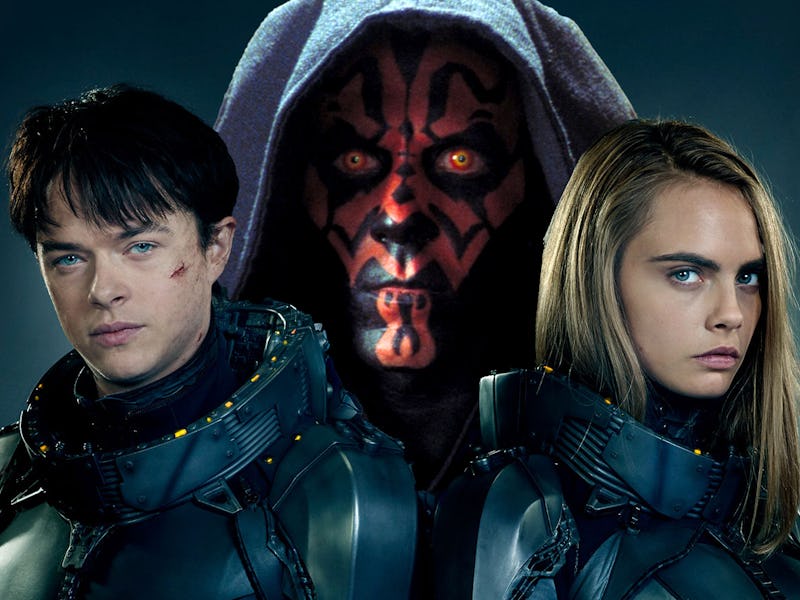Why 'Star Wars: The Phantom Menace' Is Better Than ‘Valerian’
Jar Jar and all.

Star Wars: Episode I – The Phantom Menace is a much better, more coherent science fiction film than Valerian and the City of a Thousand Planets. While both films are burdened by wooden dialogue, bad acting, and fake, goofy aliens, The Phantom Menace has a bunch of mandatory cinematic assets Valerian doesn’t: a story, characters, and stakes you actually care about.
We make this comparison because, in many ways, The Phantom Menace and Valerian are the same movie. So much so, that, in fact, you could argue that Luc Besson actually ripped off George Lucas. Both feature a pair of special agents dispatched by a crooked space government to try to get to the bottom of some corruption that is actually caused by their government. Valerian and Laureline ’s investigation isn’t thematically any different than Obi-Wan and Qui-Gon’s. It’s just that the subtly of Palpatine’s manipulation of the senate is actually way more interesting and realistic than Commander Arun Filitt (Clive Owen) trying to cover up the murder of the pearl aliens who clearly escaped from the planet Pandora.
Obi-Wan and Qui-Gon’s relationship is also more interesting and creative than Valerian and Laureline. In the latter, it’s just about some guy claiming he wants to marry someone who isn’t as keen on the idea. But, in The Phantom Menace, the partner dynamic is deeper.
Obi-Wan is more by-the-book than Qui-Gon, even though he’s younger. This smartly inverts the cliché of a young hothead who doesn’t listen to his teacher and instead puts the fussier, more conservative man in the youthful role, while the maverick uses his looser approach as a teaching tool. It’s all about whether or not someone is ready to do stuff on their own, to strike out and become independent, and what it means to be wise.
In Valerian, Laureline is clearly more competent, brave, resourceful, and skilled than Valerian; the guy is just an idiot who sleeps around a lot. Which would be like if Qui-Gon Jinn’s Jedi partner wasn’t Obi-Wan Kenobi but instead a horny Jar Jar Binks.
Functionally, Valerian is the Jar Jar Binks of his own movie. The scene in which this supposed crack agent infiltrates a marketplace in an alternate dimension plays out as slapstick comedy. Valerian bumps into people and knocks shit over. His hand is “comically” bouncing around in an alternate dimension by itself. Fans of Jar Jar must have loved this stuff: It’s exactly like when Jar Jar pisses off Sebulba in the Tatooine marketplace, only not as funny. Jar Jar was funny.
The point is, you can’t imagine The Phantom Menace working if the two lead Jedi weren’t equally competent. But Valerian asks us to go along with a movie in which only one half of the partnership is good at their job. The only difference between Valerian and Jar Jar Binks — in terms of story development — is that Valerian is less likable and doesn’t learn anything.
In terms of the conflicts faced by Valerian and Laureline, they have similar problems as Obi-Wan and Qui-Gon. Both pairs have their spaceship broken. Both meet a slave with weird powers — Anakin in The Phantom Menace, Rihanna in Valerian. And both get involved in extra-long chase sequences underwater in a movie that is supposedly about space adventure. Points for The Phantom Menace here only because Qui-Gon Jinn gets to drop that cheesy “there’s always a bigger fish” line, which Luc Besson just wished he’d written.
In Valerian, there is literally nothing to care about. The two leads seem unrealistic, the conspiracy perpetrated by Arun Filitt is so obvious, and the pearl aliens are so generic that they they seem like set dressing. At least in The Phantom Menace the Gungans were weird and not remotely sexual. In Valerian, the pearl aliens feel like they’re market-tested to be appealing to creeps.
In all the adventures of Valerian and Laureline, you never really felt like they were in any danger. This was proven true in the end when they both ended up fine.
The Phantom Menace smartly had a deadly assassin named Darth Maul chasing Obi-Wan and Qui-Gon throughout the film. Sure, Arun Filitt had his killer robots in Valerian, but they didn’t really seem dangerous. The deadliness of Darth Maul is proven in the final scenes of The Phantom Menace when Qui-Gon Jinn is stabbed to death. When are you worried about anyone in Valerian? Is Arun Filitt’s corruption as scary as Palpatine’s political deftness? As scary as a dude with horns in a black hood?
Even if you’d never seen a Star Wars movie, in The Phantom Menace you could recognize creative character dynamics, interesting plot developments, and stakes which made you care about the characters. Valerian lacks all of those qualities and can only compete with The Phantom Menace in the visual effects category.
But, again, The Phantom Menace wins, if only because it has lightsabers and Valerian doesn’t.
Valerian is out in wide release now.